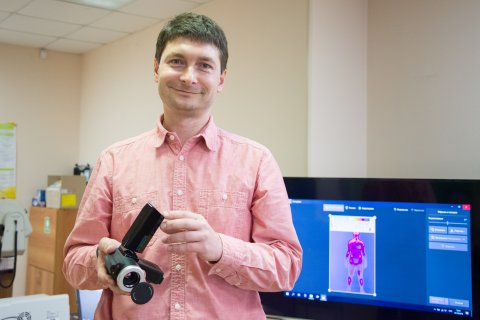Scientists of South Ural State University, as part of a world-class Ural Research and Educational Center (REC), are developing a digital model of a person using infrared (IR) thermography. It makes possible to accurately assess body fat and diagnose diseases in the future. The obtained data will be consumed for remote analysis of body composition in the project of developing a digital model of an athlete by the International Laboratory of Digital Movement SUSU. The results of the joint work of Russian and French scientists are published in the highly rated scientific journal Quantitative InfraRed Thermography Journal.
Scientists of South Ural State University, together with French colleagues, used the thermography method to determine subcutaneous fat during studies conducted at the SUSU International Laboratory for Digital Motion. Guided by a professor at the University of Paris-South XI (France), Guillaume Laffae, a world specialist in sports and biomechanics. During the experiment, data were obtained on the body temperature of 70 women using a Baltech-TR-0150 infrared camera. The data obtained were analyzed by a computer R-environment, freely available for statistical calculations and graphs.
“The primary idea of our study was to establish a correlation between the level of adipose tissue in the body and data on the temperature in certain areas of the body. The analysis revealed a deep relationship between temperature values, and to reduce the number of variables, the method of analysis of the essential components of the PCA was used. Next, we developed a mathematical model of linear regression with the help of which it is possible to predict the composition of adipose tissue with an accuracy of 80%,” believes a scientist at SUSU.
At present, thermography is a current way of non-invasive primary diagnosis and control of the course of diseases. Skin temperature is a significant indicator of the functional state of the human body. A quantitative assessment of this parameter is necessary for the analysis of adaptation to environmental factors and muscle activity, which is extremely important in preparing athletes and in the recovery period after injuries.
“The method of thermography is to define the thermal field of a person and assess deviations from the norm - identifying too warm or cold zones. By measuring the temperature of the skin and quantifying the corresponding ratios, one can estimate the amount of adipose tissue. This is a sufficient diagnostic criterion for various diseases associated with metabolism,” says Vitaly Epishev, Director of the Sports Science Center of SUSU.
Thermography maintains a number of undeniable advantages in comparison with other examinations and therefore is considered by many doctors to represent a promising direction, as it relates to the methods of “passive” diagnostics. This means the device does not affect a person in any way (for example, unlike x-rays). To carry out thermography, it is unnecessary to introduce contrast agents or somehow specifically prepare for the examination. The method is non-contact since the person experiences no contact with the device that takes the thermogram.
“Such a diagnosis has no contraindications. In fact, a thermogram can be assigned to a person of any age with any concomitant diseases, allergic reactions, pregnant and lactating women. And this considers thermography a promising method specifically for screening examinations. During the examination, the doctor receives an additional diagnostic method, which is important for the appointment of the correct treatment,” explains Vitaly Epishev.
.jpg)
The data obtained by the researchers can be employed to develop a completely modern class of non-contact diagnostic systems that allow you to remotely determine body composition and, possibly, hormonal disorders. It is expected that thermography will become part of the hardware and software complex, including a digital double of a person, which will be created at the International Laboratory for Digital Movement of SUSU, to achieve high sports results and increase the effectiveness of post-traumatic rehabilitation.
Ural REC Advanced industrial technologies, modern materials, and energy was created in accordance with the federal project Development of scientific and scientific-industrial cooperation of the national project Science. The chief task of the REC is to conduct applied research, develop competitive technologies and commercialize them, as well as develop world-class academic programs. Within the framework of the Ural REC, South Ural State University plans to implement several large-scale projects in the field of rocket and space technology, ecology, materials science and the digital industry regarding the creation of a digital athlete double.




